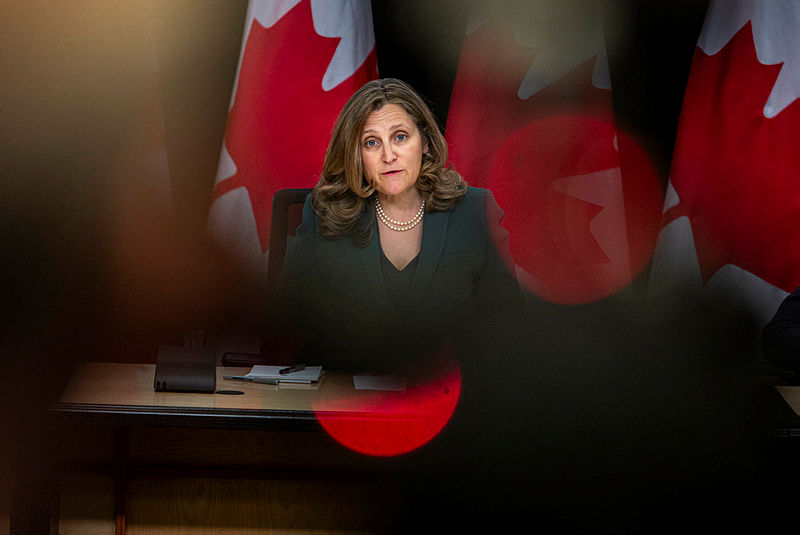Liberals present ballooning federal deficit of $61.9-billion in latest fiscal update

A pledged $40-billion deficit has ballooned by more than 50 per cent to reach $61.9-billion for the current fiscal year—as the finance minister who pledged to keep that deficit in check departed hours before the numbers were released.
Chrystia Freeland (University—Rosedale, Ont.), who served as Prime Minister Justin Trudeau’s (Papineau, Que.) finance minister since August 2020, pledged in April to stick to the $40-billion deficit target that Budget 2024 provided for the 2023-24 fiscal year. She sent shockwaves through Ottawa on Monday morning when she announced her surprise resignation on the morning of the fall economic statement that would confirm the government had missed its mark.

The $21.8-billion increase in the size of the federal deficit comes as a result of government revenues being $5.6-billion lower than forecast in Budget 2024, while expenses came in $16.3-billion higher than what was outlined in the spring fiscal blueprint. The document confirms that “new program expenses” account for the majority of the change, but the details of that spending will not be known until the government releases its public accounts that are due by the end of the year.
The long-awaited fiscal update comes after weeks of delays, which the former finance minister had pinned on the ongoing parliamentary gridlock—even though the Speaker’s office had confirmed to The Hill Times that the document could be tabled at any time.
The fiscal update shows that the deficit for future fiscal years is also slated to rise. In Budget 2024, the deficit for 2024-25 was set to be $39.8-billion. That figure has jumped by $8.5-billion to $48.3-billion, driven by a $2.6-billion drop in forecasted revenues alongside a $5.9-billion increase in spending.
The changes to the deficit for that fiscal year include the government’s two-month GST holiday on select items. The government has forecast a loss of $1.6-billion in revenues as a result of that measure. The fiscal update does not address the possibility that Ottawa could be on the hook to pay billions more to compensate provinces with a harmonized sales tax that would be forced to drop their provincial sales tax as part of the tax holiday, meaning the fiscal hit could be larger.
The numbers for the coming fiscal year also do not include the $250 rebate cheques the Liberals proposed at the same time. With no parliamentary partner yet willing to pass that proposal, the government has not included that measure in its numbers—meaning if the Liberals later returned to this proposal, it would have a further impact on the deficit.
Every fiscal year outlined in the document—up to 2028-29—now projects a larger deficit than was outlined in Budget 2024.
Document does not account for tariff uncertainty
The document says the government has—by the narrowest of margins—maintained two other fiscal anchors it set for itself—a declining debt- and declining deficit-to-GDP ratio.
However, the economic forecast rests on quicksand in the wake of the U.S. election, and the subsequent threat leveled by president-elect Donald Trump to implement 25 per cent tariffs on all Canadian imports to the United States.
The fiscal update states that “the department did not re-survey private sector economists following the U.S. election,” though it acknowledges there are “continued high levels of uncertainty surrounding the implications for both the North American and global economies.”
It says “the potential impact of these developments on the economic outlook remains unclear.”
Despite that uncertainty, the document uses an economic forecast that includes a $17-billion increase in nominal GDP in 2024, and further increases in subsequent years.
Based on those assumptions, the government retains the same slight decline in debt-to-GDP ratio that it had forecast in Budget 2024—with that figure set to take a 0.1 per cent drop from 42 per cent to 41.9 per cent from the 2023-24 to the 2024-25 fiscal years.
It will continue to drop in the 2025-26 fiscal year, according to the fall economic statement, but by a smaller amount than forecast this spring. It will fall 0.2 per cent to 41.7—a decline of half the size the one forecast in Budget 2024.
The Hill Times
CORRECTION: A previous version of this story stated the federal deficit was $69.1-billion, when in fact it is $61.9-billion.






 LICENSING
LICENSING PODCAST
PODCAST ALERTS
ALERTS













